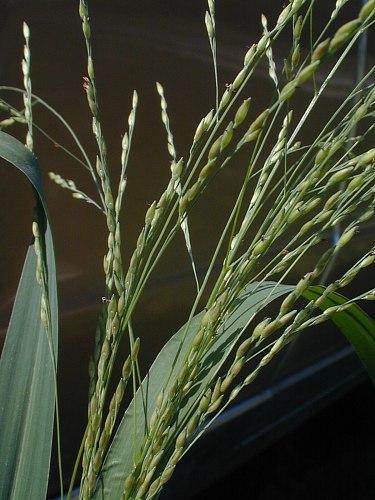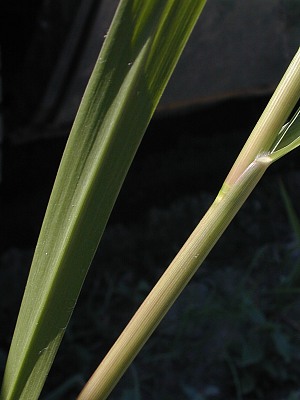Description: This grass is a summer annual about 1½–4' tall. It is often tufted at the base, sending up multiple culms (stems) that are ascending to erect. The culms are some shade of light green, terete, hairless, and largely covered by the sheaths; sometimes they branch and develop secondary culms. The blades of the alternate leaves are up to 1½' long and ¾" across, although they are usually about one-half this size. The leaf blades are medium green, linear, flat, hairless or nearly so, and rough long the margins; they usually spread outward and are rather floppy. The leaf sheaths are light green, terete or somewhat flattened, hairless, and finely veined; sometimes they are pale yellowish green or pale reddish green. The ligules have straight white hairs about 2 mm. long.

The central culm
and secondary culms (if any) terminate in airy panicles of spikelets
about ½–1¼' long and half as much across. Sometimes the panicles are
barely exerted from the uppermost sheath and rather conical in shape
toward the bottom, otherwise they are fully exerted and pyramidal in
shape. The branchlets of each panicle are very slender, light green,
glabrous, and spreading to ascending; they are straight rather than
squiggly-wiry. The small spikelets are about 3 mm. long (rarely 2 mm.
long), light green or purplish green, hairless, and ovoid-oblongoid in
shape; each spikelet has 2 glumes and 2 lemmas. The first glume is
about one-fourth the length of the spikelet (less than 1 mm.), while
the second glume is the same length as the spikelet. The outer lemma is
also the same length of the spikelet. Together, the second glume and
outer lemma enclose the inner lemma and floret of the spikelet, which
has conspicuous longitudinal veins along its outer surface. Each floret
has an ovary, 2 feathery stigmas, and 3 anthers. The blooming period
occurs during late summer into the fall. Pollination is by wind. Each
spikelet produces a single grain about 2 mm. long that is ovoid,
hairless, and somewhat flattened. The root system is fibrous. This
grass spreads by reseeding itself.
Cultivation:
This grass is typically found in full or partial sun in moist to mesic
locations. It tolerates different kinds of soil, but prefers a fertile
loam, clay loam, or silty loam. The size of each plant can be quite
variable depending on growing conditions. Most growth occurs during the
hot weather of summer because of its C4 metabolism.

Range & Habitat:
The native Fall Panicum has been collected in most counties of Illinois
(see Distribution
Map); it is quite common and probably occurs in all counties
of the state. Habitats include disturbed areas of prairies and
savannas, glades, gravel bars along rivers, fields, vacant lots, areas
along railroads, and waste areas. This grass prefers open disturbed
areas that are not too sterile and dry.
Faunal Associations:
The caterpillars of Hesperia sassacus (Indian
Skipper), Poanes hobomok (Hobomok Skipper), Polites
themistocles (Tawny-Edged Skipper), and Wallengrenia
egremet (Northern Broken-Dash) feed on the foliage of Panicum
spp. (Panic Grasses). In general, the seeds of Panic Grasses
are an important source of food to many upland gamebirds and
granivorous songbirds (see Bird Table). Rabbits and hoofed
mammalian herbivores also use Panic Grasses as a food source,
preferring the tender foliage of young plants.
Photographic Location:
A vacant lot in Urbana, Illinois.
Comments:
This common grass is one of the annual Panicum sp.
in Illinois. Other species in this group include Panicum
capillare (Witch Grass) and the introduced Panicum
milaceum (Broomcorn Millet). The latter differ from Fall
Panicum by their conspicuously hairy sheaths. A large specimen of Fall
Panicum could be confused with Panicum virgatum
(Switch Grass), which has hairless sheaths. Switch Grass is a perennial
that is often found in tallgrass prairies. It has longer spikelets
(about 4-5 mm.) and longer first glumes (about one-half the length of
the spikelets) than Fall Panicum, which has spikelets less than 3.5 mm.
in length and first glumes about one-fourth the length of the
spikelets. Because Fall Panicum is rather variable across its range,
different varieties have been identified: var. dichotomiflorum,
var. geniculatum, and var. puritanorum.
The first two varieties are occasional to common in Illinois and they
often intergrade in the field. The typical variety has an inflorescence
that is long-exerted from the uppermost leaf and it is less likely to
be tufted at the base with inflated sheaths and swollen nodes than
var. geniculatum. In contrast, var. puritanorum
has smaller spikelets (about 2 mm. long) and more narrow leaves (up to
1/3" across) than either of the preceding varieties. So far, it has
been found only in Cook County.